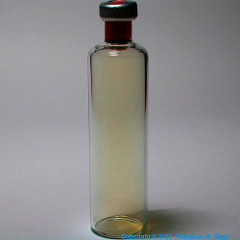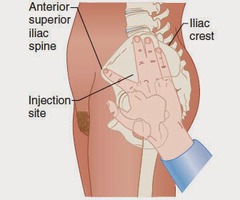Bypassing First-Pass Metabolism with Sublingual Administration
Unlock all answers in this set
Unlock answersquestion
Ampule
answer
A small, sealed glass drug container that must be broken to withdraw the medication and a special needle with a filter to draw up the medication and then replaced with a normal needle for administration
question
First-pass metabolism
answer
Metabolism of oral medication by the liver...decreasing the effect of the medication...can be bypassed by using sublingual, buccal, and parenteral routes.
question
A medication route that means NOT through the gastrointestinal tract?
answer
Parenteral route: Includes: intradermal (ID), Subcutaneous (subcut), intramuscular (IM), and intravenous (IV).
question
5-rights of delegation
answer
Right Task Right Circumstance Right Person Right Direction/Communication Right Supervision
question
Parts of a syringe
answer
Barrel Tips (slip-tip or luer-lok tip) Plunger
question
Syringe types
answer
1. Regular Syringe: 3.0, 5.0, or 10 mL IM or subcutaneous 2. TB Syringe: 1.0 mL TB, newborns and infants. 3. Insulin Syringe: ONLY insulin calibrated in units (0.3, 0.5, 1mL) 4. Prefilled Syringe: single dose, ready to use, disposable cartridges
question
Parts of a needle
answer
1. Hub: used o attached the needle to the syringe 2. Bevel: slanted tip of the needle to prevent coring and should always face upward 3. Shaft/cannual: denotes needle length-maintain sterility 4. Safety guard: safety for all once med is administrated
question
Gauge of a needle
answer
The diameter of the needle typically between 14G and 27G. The larger the #, the smaller the gauge
question
Length of a needle
answer
Needles come in different lengths ranging typically from 3/8 to 2-inches.
question
Vial

answer
A glass or plastic container of medication with a rubber stopper that must be punctured with a needle for medication removal.
question
Intradermal injections (ID)
answer
An injection of a small amount of fluid into the dermis immediately below the epidermis. Given in LVentral forearm with a 20-30G, 1/2 - 5/8 G needle put in at a 15-degree angle to create a "bleb".
question
Subcutaneous Injections (Subcut)
answer
Deposits the medication into the subcutaneous layer below the skin. Given in abdomen with a 3/8-7/8 inch; 24-29 G needle at a 45 or 90-degree angle depending on fat in abdomen. Insulin and heparin most common
question
Intramuscular Injections (IM)
answer
Injections directly into the muscle at 90 degrees using a 20-22G, 1-1.5 inch needle (adults) - Total of 2-3mL into ventrogluteal sites (gluteus medius and glutewus minimus) - Total of 1-2mL into vastus lateralis and rectus femoris - Total of 0.5-1 mL into deltoid - Total of 0.5mL into children and infants
question
Z-track injection
answer
Provides for closure of the needle track when you release the skin and tissue while an IM injection.
question
Steps/Method for Z-track method
answer
- Use side of hand to pull tissue (1-in) taut - Insert needle at 90* while holding tissue - Aspirate - Wait 10-sec - Withdraw needle - Apply pressure but DO NOT massage
question
Ventrogluteal sites include which 2-muscles?

answer
Gluteus medius and gluteus minimus muscles in the hip.
question
What are the lab values for RBC, WBC, Hgb, INR and Platletes?
answer
RBC: 4.5-5 WBC: 5-10 HgB: 11-17 INR: 2-3 Platelets: 150-450
question
Where is the rectus femoris site located?
answer
Anterior aspect of the thigh.
question
Where is the dorsogluteal site located?
answer
Upper outer quadrant of the buttocks
question
Insulin injection sites are rotated to avoid..?
answer
- Lipotrophy - breakdown of subcutaneous fat at site - Lipohypertrophy - buildup of sub-fat at site
question
What is diabetes mellitus?
answer
- A group of serious and chronic disorders affecting metabolism of carbohydrates - Glucose is the primary source of energy for the body - Glucose is transported by the blood; entry into the cells is controlled by insulin
question
What is insulin?
answer
- A hormone secreted by beta cells of the Islets of Langerhans in the pancreas - When an inadequate production of insulin or the body is unable to use the insulin it produces, glucose cannot enter the cells and it accumulates in the blood, increasing hyper-glycemia.
question
Symptoms of HYPER-glycemia
answer
- Glycosuria: glucose in the urine - Polyuria: excessive urination - Polydipsia: excessive thrist - Polyphagia: excessive appetite - Loss of weight, weakness, and fatigue
question
Complications of HYPR-glycemia
answer
- Keytones: =end product of rapid or excessive fatty-acid breakdown and made when body breaks down fat for energy; will be present in the urine when the keytones in the blood go above a certain level. - Ketoacidosis: condition in whichacids from keytones accumulate. May lead to diabetic coma, which can result in death. - Blood cells become stiff and rigid - Cause tiny tears along the inside of vessels - Plaque adheres to the tiny tears - Decreased circulation and increased complications - Atherosclerosis: major cause of death in diatetics - Retinopathy: leading cause of blindness - Arterio-scerosis - Kidney disease resulting in dialysis - Neuropathy - Infections; especially in urinary tract
question
Etiology of diabetes
answer
- Unknown - Viruses and obesity may precipitate diabetes
question
Classifications of diabetes
answer
-Prediabetes: precurser to type II - Type I: Insulin Dependent Diabetes Mellitus (IDDM) - Type II: Noninsulin Dependent Diabetes - Gestational: diabetes during pregnancy
question
What is prediabetes?
answer
- Improper use of insulin by the cells of the body - Fasting blood glucose levels ***>110mg/mL but <126mg/mL - May advance to Type II
question
What is Type II diabetes and how is it treated?
answer
- When your body either resists the effects of insulin or doesn't produce enough insulin to maintain a normal glucose level. - Treated with diet, exercise, oral meds
question
What is gestational diabetes?
answer
- Diabetes occuring during preganancy - Occurs between 16th - 28th week of pregnancy - Insulin required IF not responsive to diet and exercise - Usually disappears after the infant is born. - Predisposed to diabetes developing after 5-10 years after pregnancy.
question
Very rapid acting insulin...
answer
- Lipro (Humalog) - Onset: 15-min - Peak: 0.5 to 1.5 hours - Duration: 5 hours
question
Rapid acting insulin...
answer
- Regular Humulin R; Novulin R; and Reg Iletin II - Onset: 0.5 to 1 hour - Peak: 2-4 hours - Duration: 6-8 hours
question
Intermediate acting insulin...
answer
- Humulin U; Humulin N; Novulin N; NPH; Lente Iletin II - Onset: 1-2.5 hours - Peak: 4-15 hours - Duration: 18-25 hours
question
Long acting insulin...
answer
- Humulin U - Onset: 4-8 hours - Peak: 10-30 hours - Duration: 36-hours
question
Commercial mixed insulin...
answer
- Reg Humulin N; Humulin 70/30; Humulin 50/50; and are stable and can be administered without conern for time after withdrawal from vial - Onset: 0.5 - 1 hour - Peak: 4-8 hours - Duration: 24 hours - NOTE: When injected within 15-minutes of being combined - they act as if they have bee injected separately.
question
Method/Steps of administering heparin
answer
- May be administered subct and IV - Dosages are usually very small - Nurse does not aspirate -



